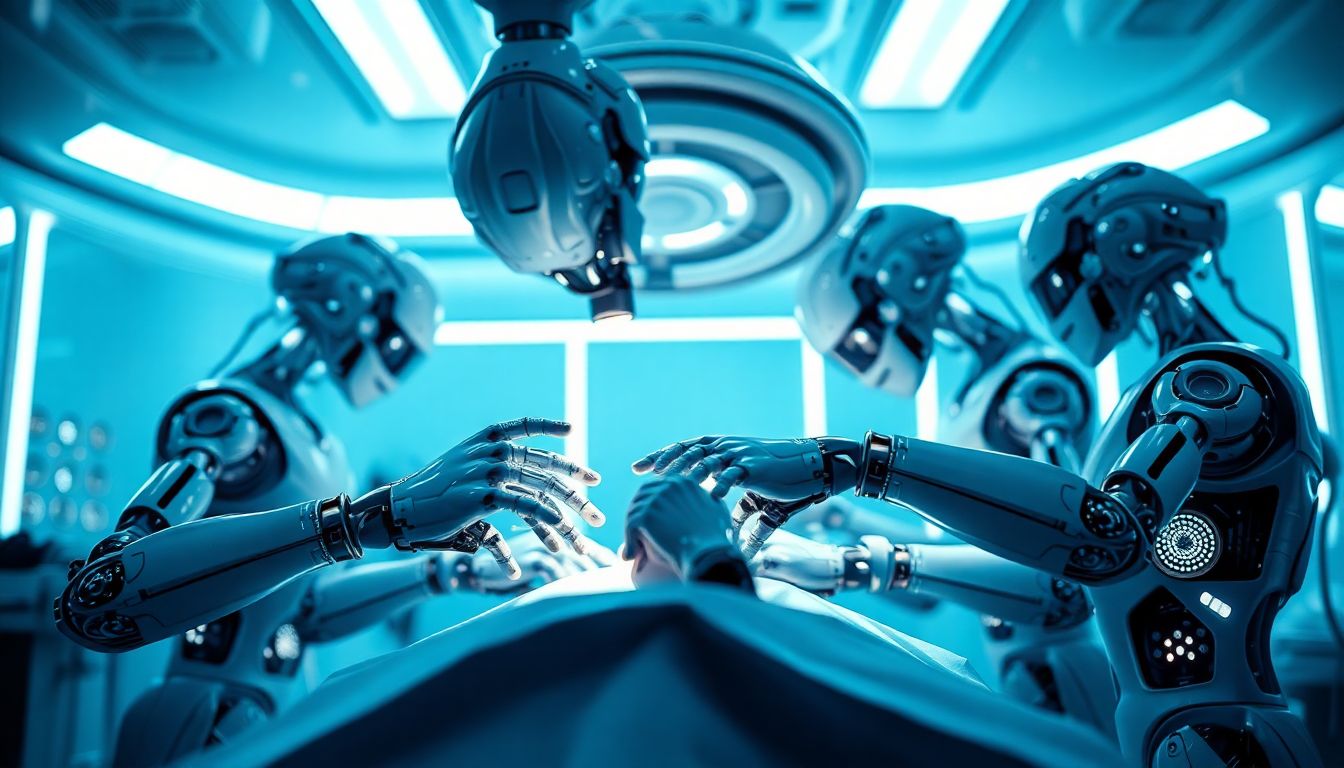Imagine a surgeon maneuvering robotic arms with extreme precision, using small incisions to remove a tumor. The patient heals more quickly and experiences less pain. This isn’t science fiction. Advanced AI medical robots are increasingly found in hospitals, transforming healthcare.
These robots assist physicians using artificial intelligence. They perform surgeries, aid in rehabilitation, and even assist in diagnostics. AI robots in the medical field are highly influential, impacting how healthcare is delivered, the benefits they bring, the challenges they pose, and what the future holds. Let’s take a closer look at AI’s multifaceted impact on healthcare.
Uses of AI Medical Robots in Healthcare
AI medical robots are used in various ways in hospitals. They assist surgeons, help with rehabilitation, and even aid in diagnostics. They significantly improve the quality of healthcare delivery.
Surgical Robots
Robotic surgery enables procedures with greater precision, smaller incisions, and quicker healing. Tools like the Da Vinci Surgical System are used by surgeons for heart, bladder, and gynecological procedures.
Robotic arms can reach areas that human hands cannot, enabling surgeries that were previously unfeasible. Patients tend to recover faster and experience less discomfort, often going home sooner.
Rehabilitation Robots
Rehabilitation robots help patients regain lost mobility after injuries or strokes. These robots assist in physical therapy, making recovery more effective.
For example, Ekso Bionics manufactures exoskeletons that enable people to walk by providing support for weak limbs. Patients can safely practice walking, improving their rehabilitation outcomes.
Diagnostic Robots
Diagnostic robots perform tests quickly and accurately. They can analyze lab samples and perform imaging, reducing human error and speeding up results.
Early diagnosis facilitated by these robots can lead to more effective treatments and potentially save lives.
Benefits of AI Medical Robots
The use of AI medical robots offers numerous advantages. They improve precision, reduce recovery times, and increase healthcare productivity.
Enhanced Precision and Accuracy
AI increases precision in medical procedures. Robots can perform tasks that are sometimes beyond human capability, reducing errors. AI-based vision allows robots to “see” better, helping them navigate complex areas.
For example, surgical robots can differentiate between tissues more effectively, excising tumors with greater accuracy and improving patient safety.
Reduced Recovery Time with Minimally-Invasive Procedures
Smaller incisions lead to faster healing. Robotic surgery results in less pain and shorter hospital stays, allowing patients to return to their lives sooner.
Minimally-invasive procedures also reduce the risk of infection, making robotic surgery a significant advancement in patient care.
Increased Efficiency and Productivity
Robots automate repetitive tasks, giving doctors more time to focus on complex cases. AI-powered robots can work continuously without breaks, increasing efficiency in overstretched hospitals.
This allows healthcare providers to deliver better care and manage their workloads more effectively.
Challenges and Limitations
Despite the advantages, AI medical robots come with challenges. High initial costs, training requirements, and ethical concerns are significant hurdles.
High Initial Costs
Robotic technology is expensive. Hospitals must invest heavily in purchasing and maintaining these systems, including software updates.
Smaller hospitals may struggle to afford this technology, potentially leading to disparities in healthcare access.
Training and Qualification Requirements
Operating these robots requires specialized training. Surgeons and staff must learn how to use these tools safely and effectively.
This adds to the overall cost and requires a commitment from hospitals to provide ongoing support and training.
Ethical and Legal Challenges
AI in healthcare raises ethical concerns, including patient data privacy, algorithmic bias, and the potential displacement of human labor.
Legal frameworks must address liability issues if robots make mistakes. Ensuring fairness and transparency in AI applications is crucial.
The Future of AI Medical Robots
The future of AI in healthcare looks promising. AI capabilities will continue to improve, and robots will integrate with telemedicine, offering more personalized treatments.
Enhanced AI Capabilities
Robots will become more advanced through machine learning. Improved computer vision and natural language processing will enhance their capabilities.
Robots will learn from each surgery they assist with, becoming more efficient and effective over time.
Integration with Telemedicine
Robots could bring healthcare to rural areas. Surgeons could perform operations remotely with robotic assistance, and doctors could diagnose patients without being physically present.
This would expand access to specialists and world-class care in underserved regions.
Personalized Medicine
AI can customize treatments based on genetic data and individual needs. Robots can ensure accurate dosages and reduce side effects, making healthcare more personalized and effective.
Conclusion
AI medical robots offer numerous advantages, including enhanced precision, reduced recovery times, and increased productivity. However, challenges such as high costs and ethical concerns must be addressed.
AI has the potential to transform healthcare, but it must be used responsibly. AI medical robots represent a significant step in healthcare evolution, and their benefits must be made accessible to everyone.

